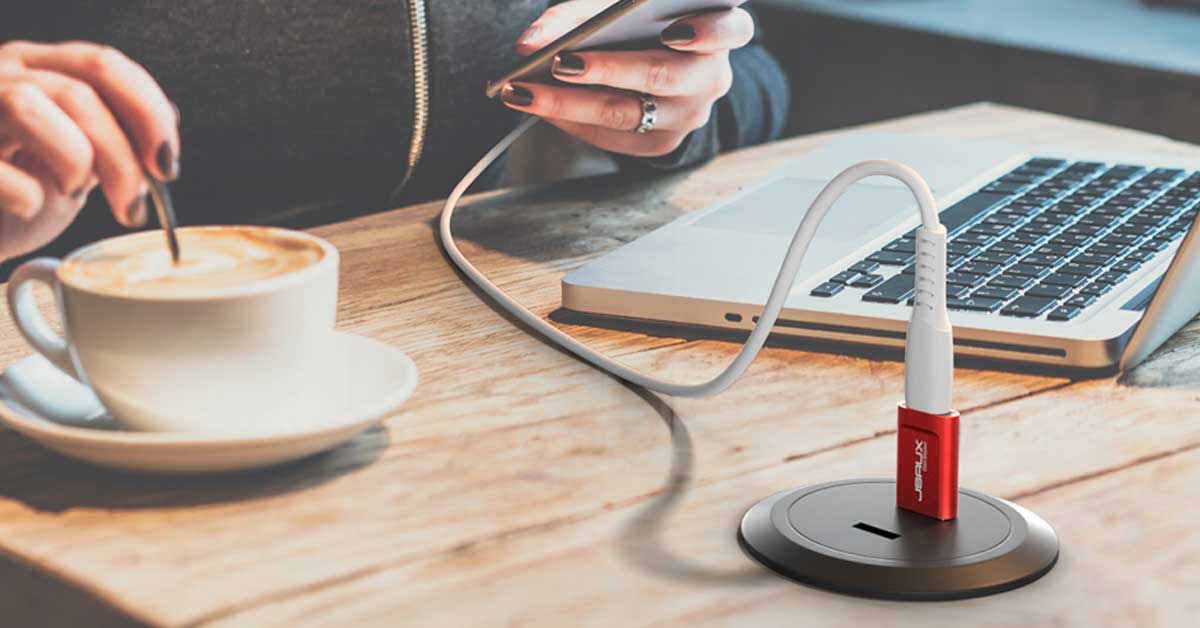Key Takeaways:
- The Amsumg USB Data Blocker is made from a heavy-duty aluminum. It can be ordered for USB Type-A to Type-A or Type-A to Type-C.
- The PortaPow USB Data Blocker comes from the UK-based brand that made the very first USB data blocker. It’s backed with a two-year warranty.
- The ZIYUETEK USB Data Blocker is a short pigtail cord, not a simple fob. It offers USB Type-C charging, and is a bit more versatile than your typical data blocker.
- Need some help? Check our FAQs section for answers to some of the most commonly asked questions regarding USB data blockers.
USB is a unique technology. Most cables can transfer either data or power, but USB can do both. In most situations, this is a good thing. Think of your phone, for example.
Thanks to your USB port, you only have to carry a single cable. Plug into your computer, and you can charge your battery while you’re transferring photos back and forth.
That said, this dual-capability has a downside. A data connection works both ways. And if you don’t control your charging port, someone else could be using it to steal your data.
This is a particularly bad problem for travelers. If you’re in an airport, for example, you may have no choice but to use one of the little charging kiosks.
Thankfully, there’s a solution. A USB data blocker is a special adapter that goes between your phone and the charging port. We’re about to review three of the best.
Ansumg USB Data Blocker
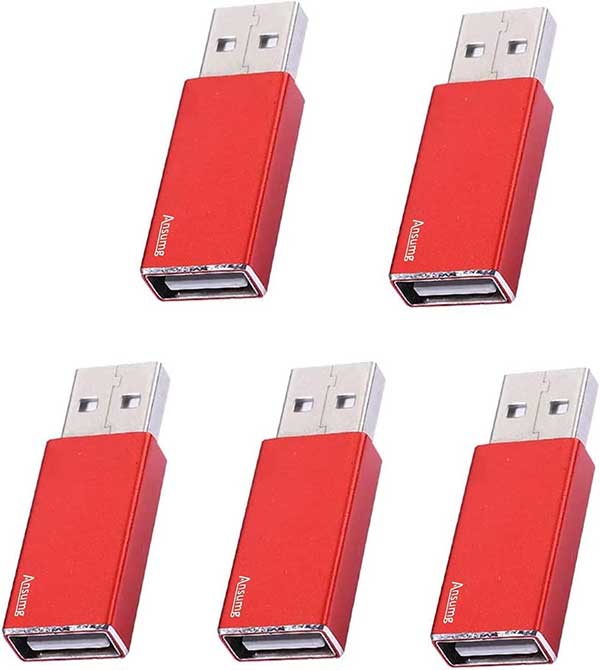
The Ansumg USB Data Blocker is a small USB pass-through fob. It’s smaller than a thumb drive, which makes it absurdly easy to bring with you on the road. You can choose between two colors: a sharp satin red and an attractive black. You can also choose between two different versions. The male end will always be USB Type-A, but the female end can be either USB Type-A or USB Type-C.
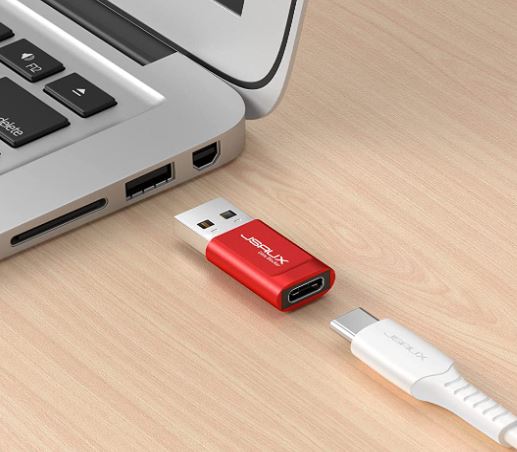
This data blocker has a tough aluminum shell that can take a serious beating. It’s rated for 10,000 plug and unplug cycle, which is enough for many years of use. It supplies 12 watts of charging current, which is the standard for USB Type-A.
Ansumg is an established manufacturer of USB cables and adapters. Not long ago, we reviewed their OTG Cable. It performed very well both for data and power transfer, and it put the brand into our heads. When we started looking for USB data blockers, we were excited to see that they made one.
PortaPow USB-C Data Blocker
PortaPow was the first manufacturer to build a USB data blocker. The UK-based company invented it in 2013, and first marketed it to government agencies. Since then, it’s been adopted by the British, American, and Canadian governments, among others. Many corporations also use it as part of their information security regime.
The PortaPow Data Blocker is the best option if you’re specifically looking for a USB-C capable option.
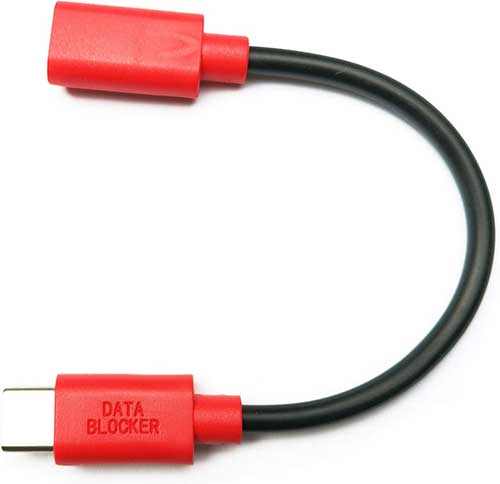
The cord itself is comprised of a slick rubber material, which provides excellent protection from most types of damage. Near the tips, there’s thick rubber reinforcement, which keeps the cord from kinking or fraying.
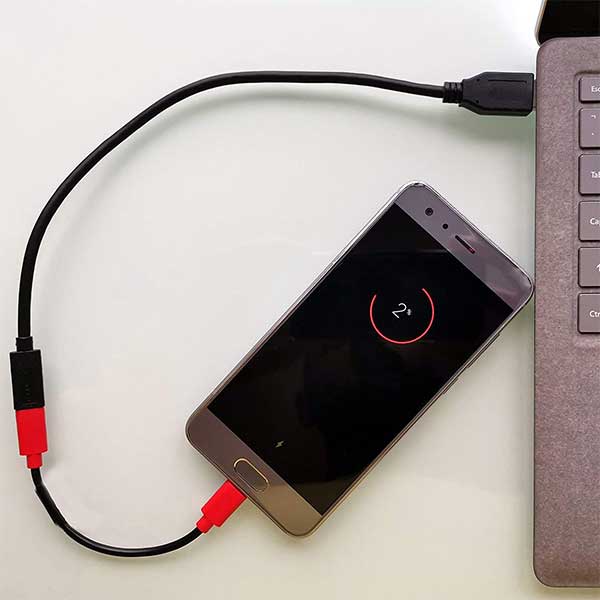
Because it’s a 6-inch pigtail, you can do things with the PortaPow data blocker that you can’t do with the others. For example, you can plug into USB-C ports that are located at an otherwise-awkward angle. But most importantly, you don’t need to carry a separate cord like you will with a USB fob. Just plug it into a charging port, and plug your phone into the other end.
This data blocker supports up to 12 watts of charging current, just like the other two on this list. It’s also rated for 10,000 plug/unplug cycles, so you get effectively limitless use.
PortaPow USB-A Data Blocker
The PortaPow USB-A Data Blocker is another small USB pass-through fob. But instead of aluminum, it’s made from plastic. It’s still reasonably durable, with three choices of color. You can order it in red or white, or go with a transparent version that lets you see the internal components. Currently, it’s only available for USB Type-A to Type-A charging.
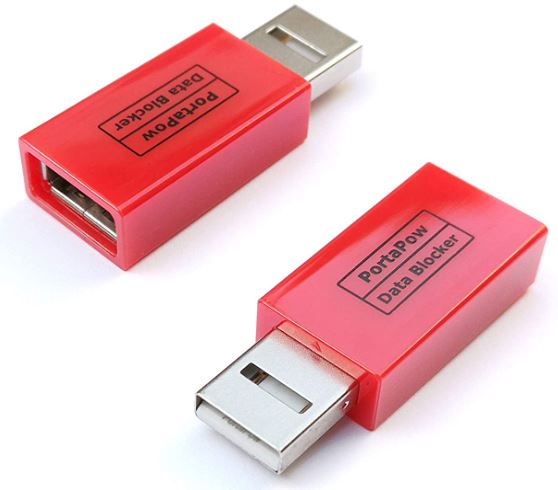
One thing we liked about this data blocker is the anti-fraud feature. There’s a cutout in the side of the male USB plug where you can see the two charging pins to the side. In the center, where the data pins would normally be, there’s no copper to be seen. Instead, the words “NO DATA” and “PortaPow” are etched into the back surface.
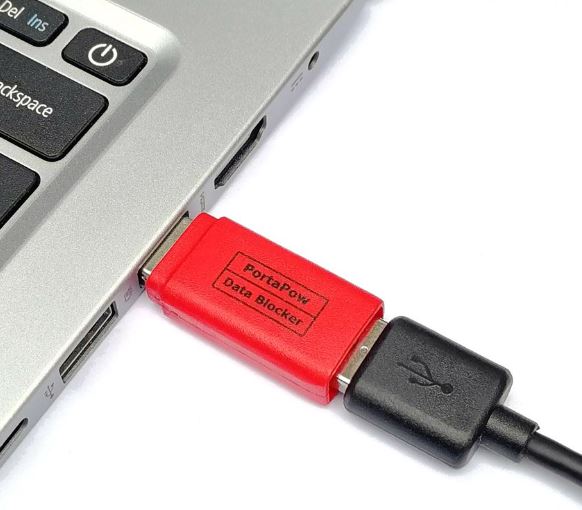
The PortaPow blocker is backed with a two-year warranty, which shows some dedication to their product. It also supports a standard 12-watt charging current so you won’t lose any performance.
How Does a USB Data Blocker Work?
In a perfect world, you’d only ever charge your devices from an AC power outlet or power bank. But we don’t live in that world. Sometimes you’re going to find yourself in a situation where you have no choice but to use a shared USB port.

Maybe you’re using a kiosk at an airport. Maybe you’re charging from a computer in a shared workspace. Regardless, someone else may have access to your data. Just like you use a VPN to protect your internet traffic, you want to use a data blocker to protect your USB port.
A data blocker is pretty straightforward. USB ports and plugs use different pins to transfer power and data. By eliminating the data pins, it becomes possible to transfer power without any data.
You can plug into a malware-riddled PC or compromised charger without a care in the world. Without any pins to transfer data, it’s literally impossible for your phone to be compromised.
Testing a USB Data Blocker
So, how do you know whether your USB data blocker is working? In some cases, like with the PortaPow blocker, it’s easy to visually identify that the data pins are missing. But if you have a USB Type-C data blocker or you just want to be double-sure, there’s an easy test.
- Plug your phone directly into your computer without going through the data blocker. Then verify that you can open your phone as a drive. In Windows, it should show up in Windows Explorer.
- Unplug your phone, then plug it back into your computer using the data blocker. Look for your phone in Explorer and verify that it’s not there. As long as you can’t see the phone, the data blocker is working.
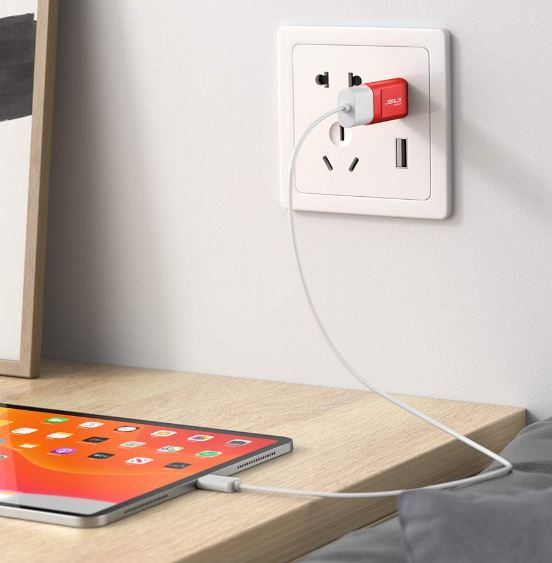
Other Ways to Keep Your Data Safe
A USB data blocker is a great way to protect your data. But at the end of the day, it’s only one method. Here are some other ways to ensure that your phone remains safe and secure:
- Use an AC adapter – Power outlets cannot transfer data or install malware on your phone. As a result, you don’t have to worry about your data being compromised.
- Use a portable power bank – A power bank might take up some space in your luggage, but it’s not going to steal your data. The UGREEN PowerDot is a great choice. It has a 10,000mAh charge, enough to charge the average smartphone three times over. It also sports both USB Type-A and Type-C ports, with a 20-watt power delivery rate.
- Deny any requests to allow data transfer – Nothing good can come from enabling data transfer when you’re plugged into anything other than your own computer.
- Turn your phone off when using a shared charging port – This makes it harder for hackers to implant malware or steal your data.
Never use a cable you find in a public area – Believe it or not, hackers can use a compromised cable to snoop on your phone.
The last thing to remember is to delete all personal data any time you get rid of a phone. If you got a new SIM card, pull the old one out and destroy it. And make extra sure you’re logged out of all personal accounts before your phone goes in the trash.
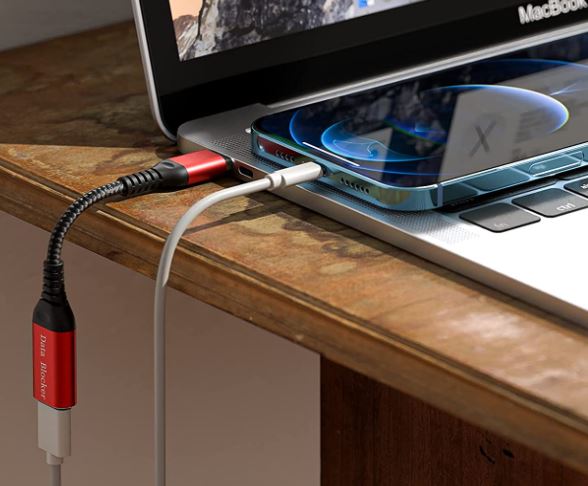
What is “Juice Jacking”?
Juice jacking is the practice of hacking someone’s phone by use of a compromised charger. This generally falls into two categories: data theft and malware installation. Let’s talk a bit about both.
Data Theft
Data theft is pretty straightforward. Hackers install malware on a public kiosk or charger. When other people connect to the kiosk, the malware searches their phones for valuable information and saves it locally. The hacker then returns some time later to retrieve the data.
The scary thing about data theft is that it can happen to anybody. We’re not talking about foreign spies targeting government employees, or master criminals targeting the super-wealthy.
These hackers are looking for credit card numbers, social security numbers, and saved passwords. They can sell this information on the dark web for a significant profit.
Malware Installation
Malware can take any number of forms. The most basic type looks for personal information, but it does so over the long term. Malware can collect not just your password and credit card, but also your GPS location, calls, and texts.
In addition, malware can use your phone itself to earn money for the hackers. They may install a cryptocurrency miner that drains your battery, or ransomware to extort you for cash. It can even be as simple as annoying adware that puts popups in all your apps.
FAQs on USB Data Blockers
What is a USB Data Blocker?
A USB Data Blocker is a device that allows charging from a USB port while blocking data transfer to keep your devices safe from potential data theft or malware when using public charging stations.
How does a USB Data Blocker work?
It works by physically disconnecting the data lines in the USB cable, only allowing power lines to connect. This prevents any data exchange between the device and the charging source.
Is a USB Data Blocker necessary?
It’s necessary if you often charge devices from public USB ports (like airports or cafes) and are concerned about the risks of data theft or malware infection.
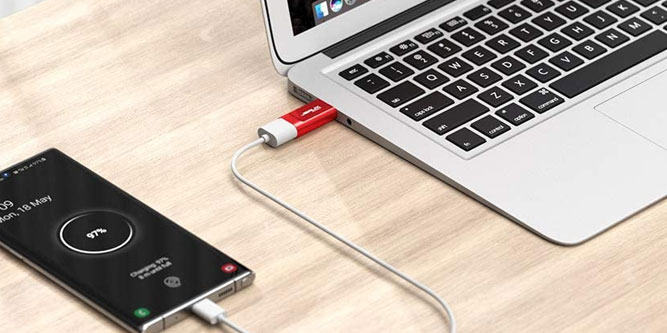
Can I use a USB Data Blocker for fast charging?
Most support standard charging speeds, but they may not support fast charging protocols that require data transfer to negotiate power delivery.
Does a USB Data Blocker work with any USB cable?
Yes, they’re designed to work with any standard USB cable and should be compatible with any device that charges via USB.
Will a USB Data Blocker affect the charging speed of my device?
It may affect charging speed if your device requires data connection for optimized charging protocols. Otherwise, it typically does not impact the basic charging function.
How do I know if my USB Data Blocker is working?
When using it, your device should charge as usual, but it should not indicate any data transfer or synchronization activity.
Final Verdict
So, which one of these USB data blockers is the right one for you? Let’s recap what we’ve learned about each one of our choices.
We began with the Amsumg USB Data Blocker.
When it comes to durability, this one takes the cake. The aluminum housing is so much tougher than plastic that there’s simply no comparison. It’s also rated for 10,000 plug/unplug cycles, which is more than you’re liable to need. And as an added bonus, you can order it with either a USB Type-A or Type-C port.
After that, we looked at the PortaPow USB Data Blocker.
It’s not made of aluminum, but it still seems very durable. PortaPow backs it with a two-year warranty, which is more than long enough to see if there’s a defect. We also loved the anti-fraud feature. If you can see the “PortaPow” etching through the window in the male plug, you know it’s the genuine article.
The last device we reviewed was the ZIYUETEK USB Data Blocker.
The thing that stands out about this data blocker is its pigtail-style design. Unlike the others, it doesn’t require a separate charging cable, so it’s far more portable. It’s also nearly as rugged as the Amsumg blocker, with an identical 10,000 plug/unplug cycle rating.
Meet Ry, “TechGuru,” a 36-year-old technology enthusiast with a deep passion for tech innovations. With extensive experience, he specializes in gaming hardware and software, and has expertise in gadgets, custom PCs, and audio.
Besides writing about tech and reviewing new products, he enjoys traveling, hiking, and photography. Committed to keeping up with the latest industry trends, he aims to guide readers in making informed tech decisions.

